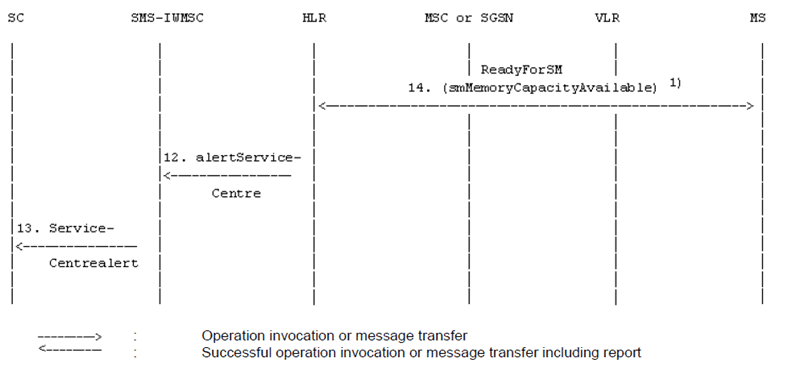Content for TS 23.040 Word version: 18.0.0
0…
3…
3.3…
4…
8…
9…
9.2…
9.2.2.2…
9.2.2.3…
9.2.3…
9.2.3.12…
9.2.3.24
9.2.3.24.1…
9.2.3.24.10…
9.2.3.24.10.1.12…
9.2.3.24.10.2…
9.2.3.24.11…
9.2.3.25…
9.3…
10…
10.1.1…
10.1.3…
10.1.5…
10.1.7…
10.1.9…
10.1.11…
10.1.13…
10.1.15…
10.1.17…
10.2
10.2.1…
10.2.3…
10.2.5…
10.2.7…
10.3
11…
A…
C
C.1…
C.3…
C.5…
C.7…
C.9…
C.11…
C.13…
C.15…
D…
E…
F…
G…
G.2…
G.6
G.7
H…
I…
J…
K…
10.3 Alert transfer p. 139
The entities involved in this procedure are depicted in Figure 19.

Figure 19: Interfaces involved in the Alert procedure. X is the interface between an SC and an MSC as defined in clause 5
(⇒ copy of original 3GPP image)
(⇒ copy of original 3GPP image)
This procedure consists of the operations shown in Figure 20.
Three cases are distinguished:
- the MS becomes reachable when the MNRF, MNRG or both are set but the MCEF is not set (Figure 20a);
- the MS becomes reachable when the MNRF, MNRG or both, and the MCEF are set (Figure 20b);
- the MS notifies the network that it has memory available to receive one or more short messages when the MCEF is set (Figure 20c).

Figure 20a: The alert procedure when the MS becomes reachable, MNRF, MNRG or both are set and MCEF is not set
(⇒ copy of original 3GPP image)
(⇒ copy of original 3GPP image)

Figure 20b: The alert procedure when the MS becomes reachable, MNRF, MNRG or both are set and MCEF is set
(⇒ copy of original 3GPP image)
(⇒ copy of original 3GPP image)

Figure 20c: The alert procedure when the MS notifies the network that it has memory available to receive one or more short messages and MCEF is set
(⇒ copy of original 3GPP image)
(⇒ copy of original 3GPP image)
Operation 11:
ReadyForSM (MS reachable).
The operation provides a means to transfer alert information from VLR or SGSN to HLR. The MSC in Deployment Option 2 (see clause 8.2.4a.1 of TS 23.272) or SGSN(or the MME for the SMS in MME feature) may provide together with the alert information the time until when an MS using extended idle mode DRX is expected to be reachable, so as to allow the SC to prioritize the retransmission of pending Mobile Terminated Short Messages to this MS.
The procedure is activated when the VLR or the SGSN detects that the MS is active, i.e. when the MS responds to a paging request.
Operation 12:
alertServiceCentre.
The operation provides a means to transfer alert information from HLR to SMS-IWMSC. The HLR may provide with the alert information the time until when an MS using extended idle mode DRX is expected to be reachable, if this information is available.
Operation 13:
ServiceCentrealert.
The operation provides a means to transfer alert information from an SMS-IWMSC to an SC. The SMS-IWMSC may provide with the alert information the time until when an MS using extended idle mode DRX is expected to be reachable, if this information is available.
The operation consists of transfer of a message ("RP-ALERT-SC") from the SMS-IWMSC to the SC.
Operation 14:
ReadyForSM (smMemoryCapacityAvailable).
The operation provides a means for the MS to notify the network that it has memory available to receive one or more short messages.
The following applies if the memory capacity available notification flag is implemented in the (U)SIM.
The operation consists of transfer of a message ("RP-SM-MEMORY-AVAILABLE") from the MS to the HLR, and the return of an acknowledgement to the MS. When the MS rejects a short message due to lack of available memory capacity the need to transfer notification shall be stored in the (U)SIM. After a attempt to transfer the RP-SM-Memory-Available message the following applies:
If the MS receives a positive acknowledgement it shall unset the memory capacity exceeded notification flag in the (U)SIM and exit this procedure.
If the MS receives a negative acknowledgement indicating a permanent failure condition (as specified in TS 24.011) it shall unset the memory capacity exceeded notification flag in the (U)SIM and exit the procedure.
If the MS receives a negative acknowledgement indicating a temporary failure condition (as specified in TS 24.011) or receives no acknowledgement or an indication of failure by lower layers, it shall repeat the attempt to transfer the message in accordance with procedures defined in TS 24.011. If these repeat procedures fail, the mobile shall unset the memory capacity exceeded notification flag in the (U)SIM and exit this procedure.
If memory capacity has become available because memory is cleared, the value of the memory capacity exceeded notification flag is read. If the flag is set, the MS notifies the network that memory capacity is now available as described above.
When the mobile is powered up or the SIM/UICC is inserted, the mobile shall check the memory capacity exceeded notification flag in the (U)SIM; if the flag is set and the MS has memory available to receive a short message the mobile shall attempt to notify the network that it has memory available, as described above.